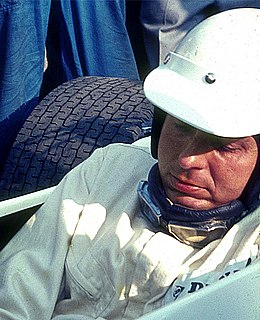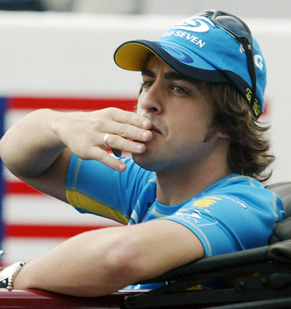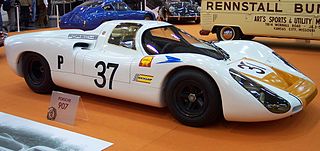
The Formula 3000 International Championship was a motor racing series created by the Fédération Internationale de l'Automobile (FIA) in 1985 to become the final preparatory step for drivers hoping to enter Formula One. Formula Two had become too expensive, and was dominated by works-run cars with factory engines; the hope was that Formula 3000 would offer quicker, cheaper, more open racing. The series began as an open specification, then tyres were standardized from 1986 onwards, followed by engines and chassis in 1996. The series ran annually until 2004, and was replaced in 2005 by the GP2 Series.

BMW has been involved in Formula One in a number of capacities since the inauguration of the World Drivers' Championship in 1950. The company entered occasional races in the 1950s and 1960s, before building the BMW M12/13 inline-four turbocharged engine in the 1980s. This engine was the result of a deal between BMW and Brabham, which resulted in the team's chassis being powered by BMW engines from 1982 until 1987, a period in which Nelson Piquet won the 1983 championship driving a Brabham BT52-BMW. BMW also supplied the M12/13 on a customer basis to the ATS, Arrows, Benetton and Ligier teams during this period, with various degrees of success. In 1988, Brabham temporarily withdrew from the sport and BMW withdrew its official backing from the engines, which were still used by the Arrows team under the Megatron badge. Turbocharged engines were banned by the revised Formula One Technical Regulations for 1989, rendering the M12/13 obsolete.
The Tyrrell Racing Organisation was an auto racing team and Formula One constructor founded by Ken Tyrrell which started racing in 1958 and started building its own cars in 1970. The team experienced its greatest success in the early 1970s, when it won three Drivers' Championships and one Constructors' Championship with Jackie Stewart. The team never reached such heights again, although it continued to win races through the 1970s and into the early 1980s, taking the final win for the Ford Cosworth DFV engine at Detroit in 1983. The team was bought by British American Tobacco in 1997 and completed its final season as Tyrrell in 1998. Tyrrell's legacy continues in Formula One as the Mercedes-AMG F1 team, who is Tyrrell's descendant through various sales and rebrandings via BAR, Honda and Brawn GP.

The DFV is an internal combustion engine that was originally produced by Cosworth for Formula One motor racing. The name is an abbreviation of Double Four Valve, the engine being a V8 development of the earlier four-cylinder FVA, which had four valves per cylinder.

Brands Hatch is a motor racing circuit in West Kingsdown, Kent, England, United Kingdom. Originally used as a grasstrack motorcycle circuit on farmland, it hosted 12 runnings of the British Grand Prix between 1964 and 1986 and currently hosts many British and International racing events. The venue is owned and operated by Jonathan Palmer's MotorSport Vision organisation.

The 1967 German Grand Prix was a motor race for both Formula One and Formula Two cars held at the Nürburgring on 6 August 1967. It was race 7 of 11 in both the 1967 World Championship of Drivers and the 1967 International Cup for Formula One Manufacturers as well a non-Championship race of the 1967 European Formula Two Championship. The 15-lap race was won by Brabham driver Denny Hulme after he started from second position. His teammate Jack Brabham finished second and Ferrari driver Chris Amon came in third.

The 1987 FIA Formula One World Championship was the 41st season of FIA Formula One motor racing. It featured the 1987 Formula One World Championship for Drivers and the 1987 Formula One World Championship for Constructors, which were contested concurrently over a sixteen-race series that commenced on 12 April and ended on 15 November. The World Championship for Drivers was won by Nelson Piquet, and the World Championship for Constructors by Williams-Honda. The season also encompassed the Jim Clark Trophy and the Colin Chapman Trophy, which were respectively contested by drivers and constructors of Formula One cars powered by naturally aspirated engines.

The 1968 Formula One season was the 22nd season of the FIA's Formula One motor racing. It featured the 19th FIA World Championship, which commenced on 1 January, and ended on 3 November after twelve races, and numerous non-championship races. Graham Hill won the second of his World Championship titles, with Lotus.

The 1967 Formula One season was the 21st season of FIA Formula One motor racing. It featured the 1967 World Championship of Drivers and the 1967 International Cup for F1 Manufacturers, contested concurrently over an eleven race series which commenced on 2 January, and ended on 22 October. The season also included a number of non-championship races for Formula One cars. Denny Hulme won the World Championship of Drivers and Brabham-Repco was awarded the International Cup for F1 Manufacturers.

Hubert Hahne was a racing driver from Germany. He was the older brother of Armin Hahne, as well as the uncle of Jörg van Ommen.

Robert Paul Hawkins was an Australian motor racing driver. The son of a racing motorcyclist-turned-church minister, Hawkins was a capable single-seater driver but really made his mark as an outstanding sports car competitor driving Ford GT40s and Lola T70s. In 1969 Hawkins was included in the FIA list of graded drivers, an elite group of 27 drivers who by their achievements were rated the best in the world.

The 2006 FIA Formula One World Championship was the 60th season of Formula One motor racing. It featured the 57th Formula One World Championship which began on 12 March and ended on 22 October after eighteen races. The Drivers' Championship was won by Fernando Alonso of Renault for the second year in a row, with Alonso becoming the youngest ever double world champion at the time. Then-retiring seven-time world champion Michael Schumacher of Scuderia Ferrari finished runner-up, 13 points behind. The Constructors' Championship was won by Renault, which defeated Ferrari by five points.

The Lotus 48 was a Formula 2 racing car designed by Colin Chapman and powered by a 1,600 cc (98 cu in) Cosworth FVA engine. Four cars were built, two of which were written off in accidents. Team Lotus ran the 48 in Formula Two in 1967 and 1968, although its first appearance was at the 1967 Australian Grand Prix, at that time a round of the Tasman Series. In 1969, the remaining two cars were purchased by Team Ireland, one of which was driven by John Watson in that year's B.A.R.C. "200" F2 event at Thruxton.

The Porsche 907 is a sportscar racing prototype built by Porsche in 1967 and 1968.

The 1979 24 Hours of Le Mans was the 47th Grand Prix of Endurance, and took place on 9 and 10 June 1979. With no other major works cars this year, the Porsche team were the strong favourites to win. Their competition would be from Cosworth-powered Mirages and Rondeaus and a swarm of Group 5 and IMSA-class Porsche 935s. The other big talking point was the presence of Hollywood actor Paul Newman, driving for Dick Barbour Racing.

The 1967 Spanish Grand Prix was a Formula One non-championship race held at Jarama on 12 November 1967.
Alfredo Costanzo is a retired Italian born Australian racing driver. From 1980 to 1983 Costanzo won a record four Australian Drivers' Championship in a row, equalling the record set by Bib Stillwell from 1962 to 1965.

The March 701 is a Formula One racing car model, designed by Robin Herd with Peter Wright, and built by March Engineering. The 701 was March's first Formula One design – following their one-off March 693P Formula Three prototype of 1969 – and was designed and built in only three months. The March 701 made its race debut a month after its public unveiling, at the 1970 South African Grand Prix. In total, eleven 701s were constructed, with March supplying many privateer entrants as well as their own works team. The 701's career started well, March drivers taking three wins and three pole positions from the car's first four race entries, but lack of development through the 1970 Formula One season resulted in increasingly poor results as the year wore on. The 701 was superseded by the March 711 in 1971, and made its last World Championship race appearance at the 1971 Italian Grand Prix.

The Matra Company's racing team, under the names of Matra Sports, Equipe Matra Elf and Equipe Matra Sports, was formed in 1965 and based at Champagne-sur-Seine (1965–1967), Romorantin-Lanthenay (1967–1969) and Vélizy-Villacoublay (1969–1979). In 1979 the team was taken over by Peugeot and renamed as Automobiles Talbot.
The Lola T102, also known as the BMW T102, is a Formula 2 car, designed, developed and built by Lola Cars, under the leadership and guidance of Eric Broadley. It competed between 1968 and 1969. It entered and competed in one Formula One Grand Prix; the 1968 German Grand Prix; where German driver Hubert Hahne finished in tenth place.
















